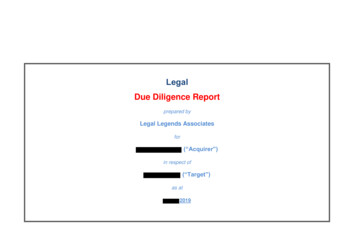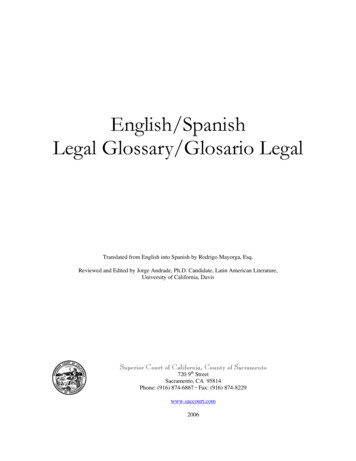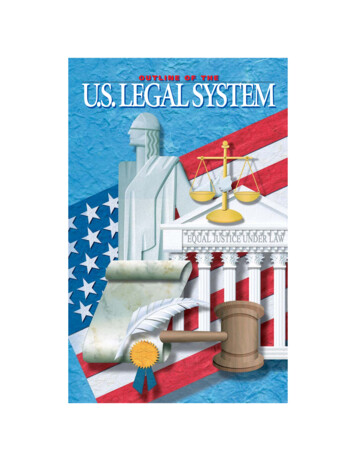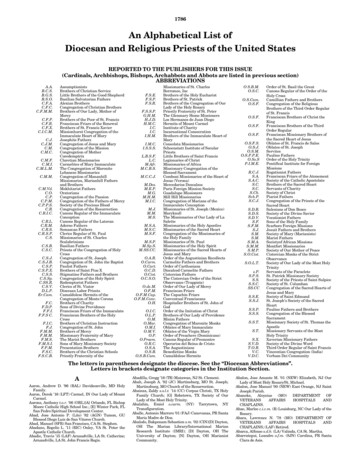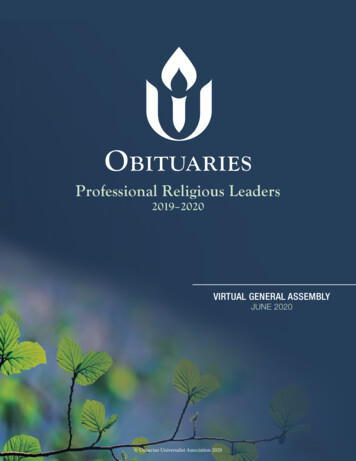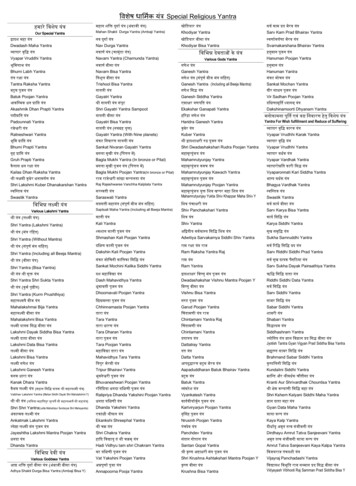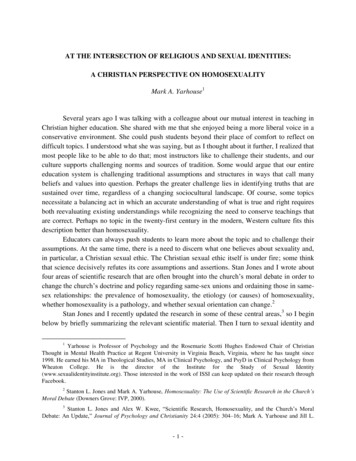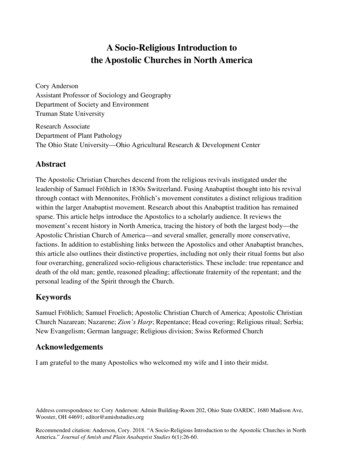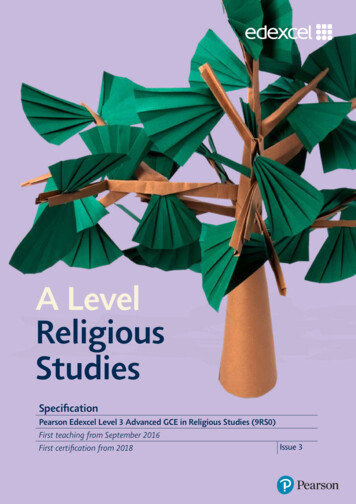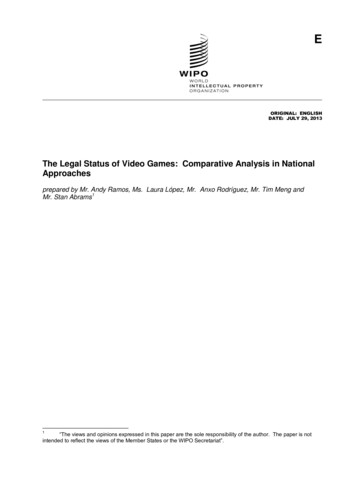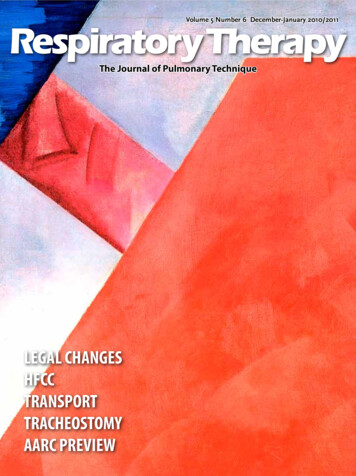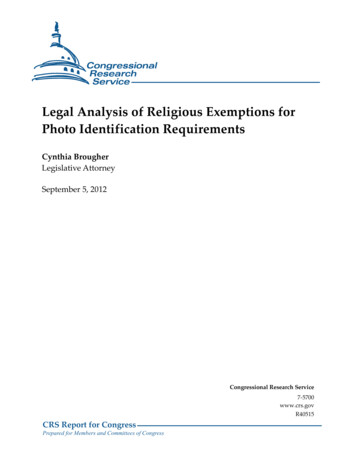
Transcription
Legal Analysis of Religious Exemptions forPhoto Identification RequirementsCynthia BrougherLegislative AttorneySeptember 5, 2012Congressional Research Service7-5700www.crs.govR40515CRS Report for CongressPrepared for Members and Committees of Congress
Legal Analysis of Religious Exemptions for Photo Identification RequirementsSummaryRecent controversies over state laws requiring voters to present identification when casting theirballots have raised questions about the burdens imposed on individuals who do not have photoidentification, including those who object to photographs based on religious beliefs. The 112thCongress has introduced a number of bills directed at so-called voter ID requirements. Congressalso has previously considered federal photo identification requirements, most recently in theREAL ID Act of 2005. A number of religious beliefs may conflict with requirements for photoidentification, leading to questions about whether a religious exemption may be required toprotect religious exercise.The Free Exercise Clause of the U.S. Constitution generally prohibits Congress from enactinglaws that restrict the free exercise of religion, guaranteeing individuals the right to practice theirreligious beliefs without government interference. To comport with the Free Exercise Clause, anyneutral law of general applicability (i.e., those that do not target religion or require individualassessments) must be rationally related to a legitimate government purpose. If a state law with aphoto requirement meets this standard of review, an exemption based on religion is not necessaryunder the federal constitution. Federal laws burdening religious exercise must also comport withthe Religious Freedom Restoration Act (RFRA), which provides a heightened level of review forsuch laws. Under RFRA, any federal law burdening religion generally must have a compellinggovernmental interest achieved by the least restrictive means possible. If the government canmeet this standard of review, an exemption based on religion is not necessary under RFRA. Statelaws requiring photo identification would be required to comport with the Free Exercise Clause,as well as with any applicable state provisions that may provide heightened standards of review.Generally, courts considering challenges to legal requirements that may infringe upon religiousexercise consider whether the religious belief is sincerely held; whether it is substantiallyburdened; and whether the government’s interest in burdening the belief is sufficient under theapplicable standard of review. These questions tend to distinguish sincere objections with actualburdens from so-called claims of convenience. In other words, courts look for evidence that theobjector’s religious exercise is in direct conflict with a particular requirement, rather than beingused as an excuse to avoid compliance with a law with which the individual merely disagrees.This report will analyze the legal issues associated with religious exemptions to photoidentification laws. Although no lawsuits appear to have challenged federal laws with photorequirements, state photo identification laws have been challenged for several decades. Afterdiscussing the legal requirements of the Free Exercise Clause and RFRA, the report will explainthe elements of analysis necessary for legal challenges involving religious objections to photorequirements. The report will also analyze lawsuits that have challenged state photo requirements,including significant factors of consideration in such cases. Finally, the report will analyze whatfactors may be relevant in future decisions that may arise related to federal photo identificationrequirements and state voter identification requirements.Congressional Research Service
Legal Analysis of Religious Exemptions for Photo Identification RequirementsContentsLegal Protections for Religious Exercise. 1Free Exercise Clause . 1Religious Freedom Restoration Act (RFRA). 2Religious Objections to Photo Identification Requirements. 3Elements of Analysis of Religious Objections to Photo Requirements. 3Sincerely Held Religious Beliefs . 3Substantial Burdens on Religious Exercise. 4Comparison of Individual Burden and Governmental Interest . 4Judicial Considerations in State Driver’s License Exemption Claims . 5Sincerity of Religious Beliefs . 5Nature of the Burden Imposed . 6Strictness of the Underlying Religious Doctrine. 6Availability of Other Exemptions or Alternative Methods of Identification. 6Purpose of the Identification Photo. 7Is an Exemption Required for Federal Identification Requirements?. 8Lawsuits Challenging Photo Requirements Under Pre-Smith Strict Scrutiny. 9Lawsuits Challenging Photo Requirements Post-9/11. 10Considerations for Potential Exemptions to Federal Photo Requirements. 10Potential Constitutional Implications of Photo Requirements in State Voter ID Laws. 11ContactsAuthor Contact Information. 13Congressional Research Service
Legal Analysis of Religious Exemptions for Photo Identification RequirementsThe recent trend in state laws requiring voters to present identification when casting theirballots has raised questions about the burdens imposed on individuals who do not havephoto identification, including those who object to photographs based on religious beliefs.1Proposed legislation in the 112th Congress addresses state efforts to implement theserequirements, including one bill that would prohibit states from requiring voter identification infederal elections.2 Photo identification has been a recurring issue in a number of contexts, andCongress recently has considered questions regarding whether photo ID can or should be requiredunder the REAL ID Act of 2005.3 Intended to improve security for driver’s licenses and personalidentification cards, the REAL ID Act also requires, without exemption, that a digital photographappear on each document. A number of religious beliefs may interfere with requirements forphoto identification, leading to questions about whether a religious exemption to photographrequirements may be required to comport with the Free Exercise Clause of the First Amendmentand the Religious Freedom Restoration Act of 19934 (RFRA).This report will analyze the legal issues associated with religious exemptions to photoidentification laws. Although no lawsuits appear to have challenged federal laws with photorequirements, state photo identification laws have been challenged for several decades. Afterdiscussing the legal requirements of the Free Exercise Clause and RFRA, the report will explainthe elements of analysis necessary for legal challenges involving religious objections to photorequirements. The report will also analyze lawsuits that have challenged state photo requirements,including significant factors of consideration in such cases. Finally, the report will analyze whatfactors may be relevant in future decisions that may arise related to federal photo identificationrequirements as well as U.S. Supreme Court opinions related to religious objections to voteridentification requirements.Legal Protections for Religious ExerciseFree Exercise ClauseThe First Amendment of the U.S. Constitution provides that “Congress shall make no lawrespecting an establishment of religion, or prohibiting the free exercise thereof.”5 These clausesare known respectively as the Establishment Clause and the Free Exercise Clause. Under the FreeExercise Clause, individuals are guaranteed the right to practice their religious beliefs withoutgovernment interference. Historically, the U.S. Supreme Court applied a heightened standard ofreview to government actions that allegedly interfered with a person’s free exercise of religion.6Under that heightened standard, the government could not interfere with a person’s religiousexercise if it did not have a compelling governmental interest.71See Crawford v. Marion County Election Board, 553 U.S. 181 (2008).H.R. 3316, 112th Cong.3P.L. 109-13.4P.L. 103-141.5U.S. CONST. Amend. I. For discussion of the constitutional and statutory standards of review used in relation to theFree Exercise Clause, see CRS Report RS22833, The Law of Church and State: General Principles and CurrentInterpretations.6See Wisconsin v. Yoder, 406 U.S. 205 (1972); Sherbert v. Verner, 374 U.S. 398 (1963).7Id.2Congressional Research Service1
Legal Analysis of Religious Exemptions for Photo Identification RequirementsIn 1990, the Court reinterpreted that standard in Employment Division, Department of HumanResources of Oregon v. Smith, holding that the compelling interest was not necessary forgovernmental interference with religious exercise in all circumstances.8 Since then, the Court hasheld that the Free Exercise Clause never “relieve[s] an individual of the obligation to comply witha valid and neutral law of general applicability.”9 Under this interpretation, the constitutionalbaseline of protection was lowered, meaning that laws that do not specifically target religion ordo not allow for individualized assessments are not subject to heightened review under theConstitution. Rather, these laws of general applicability are required only to be rationally relatedto a legitimate government purpose, and this baseline of constitutional protection analysis is oftenreferred to as rational basis review.Religious Freedom Restoration Act (RFRA)Congress responded to the Court’s holding in Smith by enacting RFRA, which statutorilyreinstated the standard of protection of heightened scrutiny for government actions interferingwith a person’s free exercise of religion.10 When RFRA was originally enacted, it applied tofederal, state, and local government actions, but the Supreme Court later ruled that its applicationto state and local governments was unconstitutional under principles of federalism.11 Therefore,RFRA now applies only to federal actions. RFRA provides that a statute or regulation of generalapplicability may lawfully burden a person’s exercise of religion only if it (1) furthers acompelling governmental interest and (2) uses the least restrictive means to further that interest.12This standard reflects the pre-Smith compelling interest requirement and is sometimes referred toas strict scrutiny analysis.In 2006, the Supreme Court addressed the issue of whether religious exemptions were requiredfrom generally applicable laws under RFRA. In Gonzales v. O Centro Espirita Beneficente UniaoDo Vegetal, the Court held that the government must demonstrate a compelling interest toprohibit any exceptions for generally applicable laws to accommodate religious exercise.13Specifically, the Court stated that the government must “demonstrate a compelling interest inuniform application of a particular program by offering evidence that granting the requestedreligious accommodations would seriously compromise its ability to administer the program.”14As a statutory enactment, rather than a constitutional standard, RFRA is not necessarilyabsolutely binding against all post-RFRA legislation. Rather, it is possible that future statutes maynot be required to comply with RFRA. In other words, RFRA may be preempted by anotherfederal law.15 Congress may amend RFRA’s scope of application generally or may providespecific exemptions from RFRA in future legislation.168494 U.S. 872 (1990).Id. at 879.10P.L. 103-141, 103d Cong., 1st Sess. (November 16, 1993); 42 U.S.C. §2000bb et seq.11City of Boerne v. Flores, 521 U.S. 407 (1997).1242 U.S.C. §2000bb-1(b).13546 U.S. 418 (2006).14Id. at 435-437.15See S.Rept. 103-111, at 12-13 (1993) (stating that “nothing in this act shall be construed as affecting religiousaccommodation under title VII of the Civil Rights Act of 1964”).16Generally, under the legal principle of entrenchment, a legislative enactment cannot bind a future Congress. That is,(continued.)9Congressional Research Service2
Legal Analysis of Religious Exemptions for Photo Identification RequirementsReligious Objections to Photo IdentificationRequirementsMembers of some religious groups may object to having their photograph taken as manyidentification laws require. The teachings of several religious groups may prohibit their membersfrom being photographed in general or from revealing some parts of their body. For instance,some Christians, including some Amish, believe photographs violate the Ten Commandments.Members of other religious groups may believe that members must wear head coverings or veilsfor religious reasons. Identification laws that require individuals to be photographed or requireindividuals to be photographed without religious head covering may infringe upon theseindividuals’ First Amendment right to exercise their religious beliefs freely, leading to potentiallegal challenges to determine whether the individuals’ First Amendment right must beaccommodated. The most common type of identification law to be challenged are state driver’slicense laws, but the legal issues may also apply in other cases with photograph requirements.Elements of Analysis of Religious Objections toPhoto RequirementsIn challenges to legal requirements that may infringe on an individual’s religious exercise, courtsgenerally consider three questions: (1) Is the individual’s religious belief sincerely held?; (2)Would the legal requirement impose a substantial burden on the individual’s religious exercise?;and (3) Is the burden sufficient to overcome the government’s interest in applying the requirementwithout an exemption?17Sincerely Held Religious BeliefsIn order for an individual’s religious beliefs to be protected by the Free Exercise Clause, thebeliefs must be sincerely held. An individual’s beliefs are not required to conform with the beliefsof other members of his or her religious group, nor is the individual required to be a member of areligious group at all.18 Furthermore, the accuracy of an individual’s religious belief need not beverified by factual findings. The U.S. Supreme Court has held that courts are not to judge thetruth or falsity of religious beliefs.19 Instead, courts generally examine whether the individualapplies the belief consistently in his or her own practices.(.continued)Congress cannot entrench a legislative action by providing that it may not be repealed or altered. See Fletcher v. Peck,10 U.S. 87, 135 (1810) (Chief Justice Marshall) (“The principle asserted is, that one legislature is competent to repealany act which a former legislature was competent to pass; and that one legislature cannot abridge the powers of asucceeding legislature. The correctness of this principle, so far as respects general legislation, can never becontroverted.”). The U.S. Supreme Court has noted the long history of this rule. See United States v. Winstar Corp.,518 U.S. 839, 872-74 (1996).17See Quaring v. Peterson, 728 F.2d 1121 (8th Cir. 1984), aff’d by divided court, 472 U.S. 478 (1985).18See Thomas v. Review Board, 450 U.S. 707 (1981) (“The guarantee of free exercise is not limited to beliefs whichare shared by all the members of a religious sect.”).19United States v. Ballard, 322 U.S. 78 (1944).Congressional Research Service3
Legal Analysis of Religious Exemptions for Photo Identification RequirementsSubstantial Burdens on Religious ExerciseEven if an individual’s belief is sincerely held, the government action that allegedly infringes onthat belief must impose a substantial burden on the individual’s religious exercise. A substantialburden on religious exercise is one that puts “substantial pressure on an adherent to modify hisbehavior and to violate his beliefs.”20 The Supreme Court has required evidence that the legalrequirement in question violates the individual’s sincerely held belief.21 That is, if the legalrequirement that the individual opposes does not actually interfere with the religious practice, thegovernment may still require the individual to comply with the requirement. For example, areligious organization challenged the imposition of a sales tax on religious products that it sold,claiming the tax burdened the organization’s religious exercise. The organization’s religiousdoctrine did not include a belief that payment of taxes was forbidden, but rather claimed that thegovernment was taking part of the money it raised as a part of its religious practice. The SupremeCourt held that a sales tax applied generally to products distributed by religious and non-religiousentities did not constitute a significant burden on religious exercise because the tax itself did notviolate the religious entity’s sincerely held beliefs.22 Therefore, in the case of a religiousorganization’s objections to paying sales tax on products it sells, the organization would besubstantially burdened by the tax if its sincerely held beliefs prohibited the payment of taxes,because the tax requirement forces the organization to act in violation of its beliefs. However,because the action being regulated by the government was not one that directly affected theorganization’s sincerely held beliefs, the Court held that the burden did not implicate theorganization’s religious exercise.23Comparison of Individual Burden and Governmental InterestOnce a court has determined that a substantial burden has been imposed on a sincerely heldbelief, it must balance that burden on the individual’s religious exercise with the governmentalinterest associated with it. That is, the right to religious exercise is not absolute. Burdens onreligious exercise may be constitutionally permissible if the appropriate legal standard is met. Thestandard that this balance must meet is determined by the applicable law protecting religiousexercise. For cases brought under the Free Exercise Clause of the U.S. Constitution, thegovernmental interest generally may be deemed to outweigh the burden on religious exercise ifthe governmental action is rationally related to a legitimate government purpose—the minimumconstitutional standard of review sometimes referred to as rational basis review.24 For casesbrought under the heightened statutory standard provided by RFRA, the governmental interestoutweighs the burden on religious exercise if the government has a compelling interest that isachieved by the least restrictive means to meet that end—the strict scrutiny standard of review.Cases may also be brought under state constitutional or statutory provisions relating to freeexercise, which may impose either of these standards.20See Thomas v. Review Board, 450 U.S. at 717-18.Jimmy Swaggart Ministries v. Board of Equalization, 493 U.S. 378 (1990).22Id. at 391-92.23Id.24See Smith, 494 U.S. 872.21Congressional Research Service4
Legal Analysis of Religious Exemptions for Photo Identification RequirementsJudicial Considerati
objector’s religious exercise is in direct conflict with a particular requirement, rather than being used as an excuse to avoid compliance with a law with which the individual merely disagrees. This report will analyze the legal issues assoc
